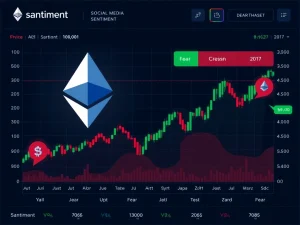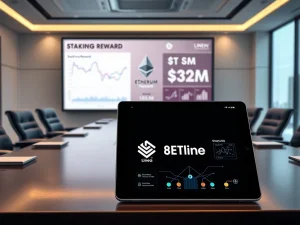XRP Ledger’s Breakthrough: Ripple Patent Unlocks Revolutionary Temporary Consensus for Global Finance

Are you ready for a seismic shift in how global finance operates? For years, the promise of cryptocurrencies has been to revolutionize payments, and now, Ripple is taking a giant leap forward with a groundbreaking XRP Ledger patent. This isn’t just news; it’s a potential game-changer for the future of money, promising unprecedented speed and efficiency in the world of digital assets and traditional finance alike.
Unveiling the Ripple Patent: A New Era for XRP Ledger Consensus
At the heart of this innovation lies Ripple’s European patent EP3054405A1, meticulously analyzed by crypto researcher Stern Drew. This patent introduces a novel blockchain framework called “Temporary Consensus Subnetworks” (TCSN). Imagine a world where transaction validation on the XRP Ledger (XRPL) isn’t solely reliant on the entire network, but can be efficiently handled by smaller, temporary groups of trusted validators.
Here’s how this ingenious mechanism reconfigures transaction validation:
- Dynamic Subnetworks: Instead of every validator on the XRPL needing to confirm every payment, senders and receivers can select specific, trusted validators for a particular transaction.
- Rapid Validation: These selected validators form a temporary subnetwork, approving the payment within seconds. This localized consensus drastically cuts down validation time.
- Transparent Finality: Once validated by the subnetwork, the transaction result is then shared with the broader XRPL validator set, ensuring transparency and maintaining the integrity of the overall ledger.
According to Stern Drew, this innovation significantly enhances transaction speed and security while critically maintaining the decentralization that blockchain technology promises. It positions XRP as a pivotal asset in evolving cross-border financial systems, offering a glimpse into a more efficient future.
Revolutionizing Cross-Border Payments: Beyond SWIFT’s Limitations
The implications of this Ripple Patent for global financial infrastructure are profound. Consider the traditional methods for international settlements, such as SWIFT. These systems often require days for transactions to settle, involve multiple intermediaries, and incur substantial fees. They are built on a legacy framework that, while reliable, is increasingly showing its age in a digitally driven world.
The Temporary Consensus Subnetworks framework offers a stark contrast:
| Feature | Traditional Systems (e.g., SWIFT) | XRP Ledger with TCSN |
|---|---|---|
| Settlement Time | Days | Seconds (near-instant) |
| Intermediaries | Multiple | Minimal to none |
| Fees | High | Significantly lower |
| Scalability | Limited by legacy infrastructure | Enhanced by flexible subnetworks |
By enabling near-instant payment finality, this patent could streamline high-value transactions, making it particularly relevant for emerging use cases like central bank digital currencies (CBDCs) and tokenized assets. Stern Drew emphasizes that Ripple’s system is designed for institutional-scale operations, where trust, speed, and cost-efficiency are paramount. This is a clear signal of Ripple’s intent to bridge the gap between traditional finance and the efficiencies of blockchain.
XRP’s Pivotal Role in Global Financial Infrastructure
Within this innovative framework, XRP is designed to act as a neutral bridge asset. Its purpose is to facilitate seamless value transfers between disparate currencies or tokenized forms of capital. Imagine a financial institution in one country needing to send value to another in a different currency; XRP can act as the instantaneous intermediary, settling the transaction efficiently.
The variable validator model, a key component of the patent, allows institutions to adjust security parameters based on the specific needs of a transaction. For instance:
- Small Payments: Prioritize speed and efficiency with a smaller, highly trusted subnetwork.
- Large, High-Value Transactions: Enhance consensus strength by involving a larger or more diverse set of validators, balancing efficiency with stringent risk management.
This flexibility is crucial for institutional adoption, as it allows for customization that legacy systems simply cannot offer. Stern Drew argues that this patent reflects Ripple’s strategic shift from speculative blockchain applications to foundational financial architecture, embedding XRP directly into the plumbing of global financial infrastructure.
Scalability and Customization: The Power of Temporary Consensus
The Temporary Consensus Subnetworks model addresses one of blockchain’s biggest challenges: scalability. By allowing transactions to be validated by smaller, temporary groups, the overall network load is reduced without compromising decentralization. This approach offers both scalability and customization, aligning perfectly with the demands of institutional finance for reliable, high-volume cross-border payments solutions.
Ripple’s vision is clear: to provide a decentralized yet institutionally robust alternative to legacy systems by integrating XRP into settlement layers. The researcher describes this as a technical advancement rather than a speculative strategy, underscoring the patented architecture as evidence of Ripple’s long-term vision to embed XRP in global financial infrastructure. The patent’s focus on institutional use cases suggests potential adoption by central banks and financial entities seeking to tokenize real-world assets.
This ability to calibrate validator sets per transaction—prioritizing speed for smaller payments or enhancing consensus strength for larger ones—is a key differentiator. It enables the XRP Ledger to adapt to diverse financial scenarios while retaining its core principle of decentralization. This flexibility is what could truly unlock the potential of digital assets for the global economy.
A Glimpse into the Future of Finance
Ripple’s patent for Temporary Consensus Subnetworks represents a significant stride towards a more efficient, secure, and decentralized global financial system. By optimizing transaction validation on the XRP Ledger, Ripple is not just enhancing XRP’s utility but laying down a foundational layer for the next generation of financial infrastructure. This innovation could very well redefine how institutions conduct high-value transactions, paving the way for broader adoption of digital assets in mainstream finance.
Frequently Asked Questions (FAQs)
What is the “Temporary Consensus Subnetworks” patent?
It’s a novel blockchain framework introduced by Ripple’s European patent EP3054405A1. It allows for transactions on the XRP Ledger to be validated by smaller, temporary groups of trusted validators rather than the entire network, significantly enhancing speed and efficiency.
How does this patent improve XRP Ledger transactions?
By enabling dynamic subnetworks of validators, it allows for near-instant transaction finality (within seconds), improves security through tailored consensus, and maintains decentralization, making the XRP Ledger more scalable and adaptable for high-volume institutional use.
What are the implications for institutional finance?
This patent could revolutionize institutional finance by offering a faster, more cost-effective, and secure alternative to traditional systems like SWIFT for cross-border payments. It is designed to support emerging use cases such as Central Bank Digital Currencies (CBDCs) and tokenized assets, meeting the demands for trust and speed in large-scale operations.
How does XRP function within this new framework?
XRP acts as a neutral bridge asset, facilitating seamless and instantaneous value transfers between different currencies or tokenized forms of capital. Its role is to enable the efficient flow of liquidity across these temporary consensus subnetworks.
Does this make XRP centralized?
No, the patent emphasizes that the Temporary Consensus Subnetworks framework maintains decentralization. While smaller groups of validators are used for specific transactions, the results are shared with the broader XRP Ledger validator set for transparency and overall network integrity, ensuring that the core decentralized nature is preserved.
When might we see this technology in action?
While the patent lays the technical groundwork, the exact timeline for its full implementation and widespread adoption in live institutional settings will depend on further development, regulatory considerations, and partnerships. However, it signals Ripple’s clear long-term vision for XRP’s role in global financial infrastructure.








